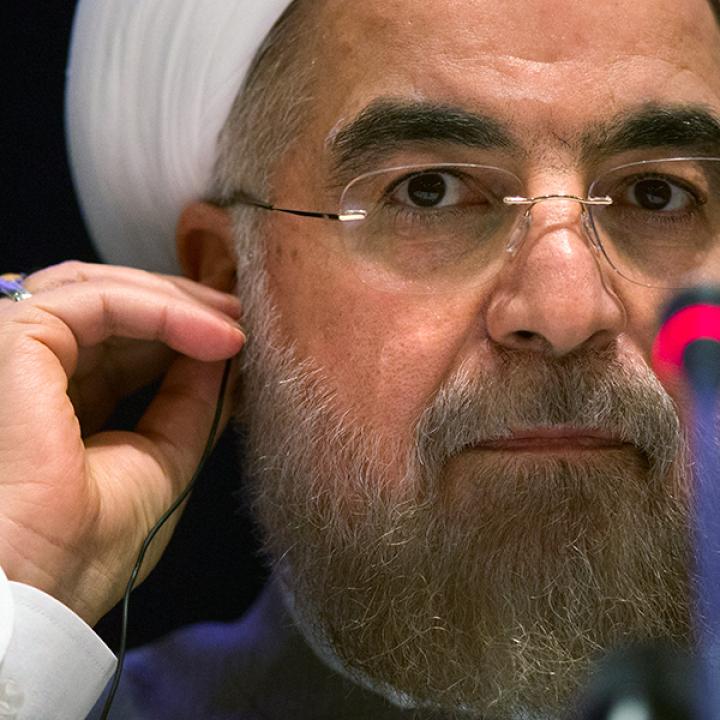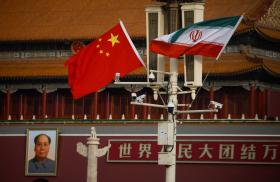

His troubling numbers could be accurate given Iran’s past JCPOA violations and large number of operational centrifuges.
On January 16, in live remarks broadcast on Iranian state television, President Hassan Rouhani stated that his country was enriching more uranium today than before the 2015 Joint Comprehensive Plan of Action. If true, this represents an extraordinary ramp-up in its monthly enriched uranium production since the International Atomic Energy Agency’s last accounting visit on November 3. Such high production levels were the main impetus for brokering the nuclear agreement in the first place, since Iran’s breakout time—that is, how long it would need to produce enough enriched uranium for a nuclear weapon—had become frighteningly short as a result.
A closer look at pre-JCPOA data can provide a baseline for Rouhani’s assertion. From May 2012 to May 2014, Iran was producing enriched uranium at an average rate of 232 kg per month (this figure applies to material enriched to less than 5%; for an explanation of enrichment percentages and their relation to potential weaponization, see The Washington Institute’s glossary of essential nuclear terminology). It used approximately 9,000 IR-1 (or first-generation) centrifuges at its main Natanz facility for this effort. When production began to ramp down at the end of 2015 in anticipation of the JCPOA being implemented, the rate fell to its lowest monthly level, around 156 kg (the JCPOA was agreed to in July 2015, but not implemented until January 2016).
In the most recent IAEA report, based on the period August 19-November 3, 2019, Iran’s stockpile grew by approximately 52 kg per month, if one combines its 3.67% and 4.5% enriched uranium. To bring its stockpile up to pre-JCPOA levels by the time of Rouhani’s latest claim, Iran would have had to increase that monthly enrichment rate at least threefold since November (to 156 kg), if not more (e.g., to 232 kg, depending on one’s definition of “pre-JCPOA”).
Rouhani’s comments may not be hyperbole. Given what is known about Iran’s centrifuges, reaching pre-JCPOA levels was always a plausible feat once it decided to start violating various JCPOA restrictions. Specifically, it could have achieved these levels by increasing its use of IR-1 centrifuges, and/or by running its advanced centrifuges, which are supposed to have significantly higher output than the IR-1. Iran announced that it would begin using advanced centrifuges several months ago, and the IAEA has confirmed that they are running and accumulating uranium. Since the advanced machines were not accumulating uranium pre-JCPOA, it is unclear how well they work, but if operating as expected they could explain the bulk of Rouhani’s claimed ramp-up.
On January 5, Iranian officials alluded to increasing their use of IR-1 centrifuges as part of a “fifth step” away from their JCPOA commitments. Factoring in how many IR-1 machines Iran has replaced since the start of the JCPOA due to normal wear and tear, it may have up to 4,600 additional machines available for use. Combined with the 5,060 already in use, that would allow Iran to ramp back up to the 9,156 IR-1 centrifuges it was using prior to the JCPOA. And if advanced centrifuges are added to the mix, it could easily surpass its pre-JCPOA production of enriched uranium.
The exact details behind Rouhani’s claim will become clear when the next IAEA report on Iran comes out in early February. It will be the first such report issued under the new IAEA chief, Rafael Grossi, and the first to reveal how efficient the advanced centrifuges are at enriching uranium.
The next troubling step Iran could take would be to increase enrichment from 4.5% to 19.75%, which is technically quite close to weapons-grade uranium. If Tehran is able to grow its stockpile as quickly as Rouhani claims, and if it boosts enrichment to 19.75%, this would raise the same concerns that existed prior to the JCPOA about its potentially short breakout time.
Elana DeLozier is a research fellow in The Washington Institute’s Bernstein Program on Gulf and Energy Policy.



